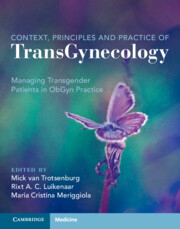Book contents
- Context, Principles, and Practice of Transgynecology
- Context, Principles, and Practice of Transgynecology
- Copyright page
- Dedication
- Contents
- Foreword
- Preface
- Contributors
- Abbreviations
- Section A Contextual Transgynecology
- Section B Practicing Transgynecology
- Section C Gynecological Surgery for Transgender Males
- Section D Sexuality and Contraception
- Section E Fertility and Reproduction
- Chapter 24 Fertility Counseling for Transgender and Nonbinary People
- Chapter 25 Management of Fertility for the Trans Masculine Individual
- Chapter 26 Fertility Maintenance for Trans Women
- Chapter 27 Fertility Prospects Related to Puberty Blocking Therapy
- Chapter 28 Medico-legal Entanglements of Assisted Reproduction
- Chapter 29 Obstetrical Care for Trans Persons
- Chapter 30 Uterine Transplantation for Trans Women: Prerequisites and Limitations
- Section F Impact of Gender-affirming Hormonal Therapy on Genital Organs
- Section G Screening and Prophylaxis
- Transgynecology Index
- References
Chapter 28 - Medico-legal Entanglements of Assisted Reproduction
from Section E - Fertility and Reproduction
Published online by Cambridge University Press: 22 December 2022
- Context, Principles, and Practice of Transgynecology
- Context, Principles, and Practice of Transgynecology
- Copyright page
- Dedication
- Contents
- Foreword
- Preface
- Contributors
- Abbreviations
- Section A Contextual Transgynecology
- Section B Practicing Transgynecology
- Section C Gynecological Surgery for Transgender Males
- Section D Sexuality and Contraception
- Section E Fertility and Reproduction
- Chapter 24 Fertility Counseling for Transgender and Nonbinary People
- Chapter 25 Management of Fertility for the Trans Masculine Individual
- Chapter 26 Fertility Maintenance for Trans Women
- Chapter 27 Fertility Prospects Related to Puberty Blocking Therapy
- Chapter 28 Medico-legal Entanglements of Assisted Reproduction
- Chapter 29 Obstetrical Care for Trans Persons
- Chapter 30 Uterine Transplantation for Trans Women: Prerequisites and Limitations
- Section F Impact of Gender-affirming Hormonal Therapy on Genital Organs
- Section G Screening and Prophylaxis
- Transgynecology Index
- References
Summary
Fertility preservation has become a hot issue in transgender medicine. Today counseling on this aspect prior to the start of treatment is regarded mandatory. However, reproductive consequences and options in the context of gender-affirmative treatment remain far from clear. Transgender people face multiple medical and legal problems when trying to achieve parenthood using the help of assisted reproduction. This is a result of two main causes: (1) In many cases, the knowledge of fertility preservation is not available to the concerned parties before gender reassignment, as well as the methods of fertility treatments afterwards. There is also a lack of such knowledge within the health system; (2) National laws do not take into consideration the special needs and challenges of this patient group as they consist solely of general rules for cis couples trying to conceive.
This chapter offers a list of assisted reproductive technology (ART) methods available for transgender people and points out their medico-legal challenges. The authors think ahead and think through the consequences of various constellations for assisted reproduction. The chapter is an inexhaustible source for providing up-dated information on fertility options for trans- and gender diverse people. Moreover, this chapter points to the numerous legal weaknesses in legislation on reproductive issues and the discriminatory consequences for people beyond the gender binary.
Keywords
- Type
- Chapter
- Information
- Context, Principles and Practice of TransGynecologyManaging Transgender Patients in ObGyn Practice, pp. 206 - 217Publisher: Cambridge University PressPrint publication year: 2022



